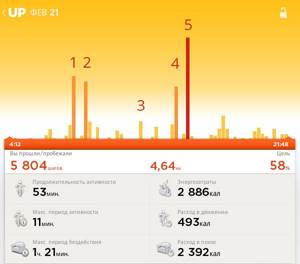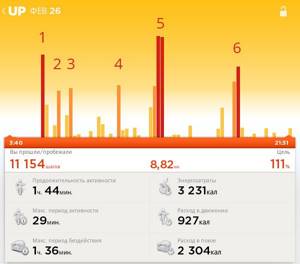An American scientist spoke out against a common fitness myth. And we found out what athletes think about this.
Alexandra Chukhrai · February 26, 2017
More than half a century ago, Japanese researchers presented the world with the fruits of their labors. Scientists from the Land of the Rising Sun have given a lot of arguments in favor of the fact that for a healthy body and spirit you need to walk 10 thousand steps a day to burn 3 thousand calories. This figure has become a rule around the world, which tens of millions of people have followed in 50 years.
But science does not stand still. Especially American. Overseas researchers are making new discoveries every day, one of which concerns the notorious 10 thousand steps. As a result, experts were completely confused in their search for an answer to the question regarding the Japanese theory. On occasion, the editors of Woman's Day decided to find out the opinions of both sides.
Against
According to a professor at Johns Hopkins University, the conclusions of Japanese colleagues 50 years ago are erroneous. Greg Hager said this at the annual meeting of the American Association for the Advancement of Science. 10 thousand steps are not only not beneficial, they can be harmful, reports The Telegraph.
Not only did this rule apply to the population of Japan, the majority of whom were not overweight and had many qualities unique to the Japanese.
Hager emphasized that no one has conducted a single correct study that could prove the usefulness of such a number of steps and not harm to health.
And here is what a specialist, whose job is daily instruction in Nordic walking, thinks about this.
“Even more harm comes from the reluctance to give yourself any stress at all,” says Alexander Smirnov, coach of the Nordic Walking Center. — I never took the number 10 thousand steps a day literally, because it is from the same series as the statement about the need to drink 2 liters of water a day. It is impossible to develop a single formula for each person, because all people have completely different anthropometric data, on which the duration and technique of training depends. Each body has a different response to stress, so you must first of all understand your capabilities and feel that this will not be harmful.
Nordic walking is much more effective in this sense compared to regular walking, because in addition to the legs, the arms and back muscles also work.
For some, 10 thousand steps is too much, for others it’s not enough. Someone walks, stepping incorrectly, putting weight on their feet, clubbing, which can be completely disastrous. For some, on the contrary, this will be extremely useful, because this is the only load that he can afford.
The average effective workout is 5-6 kilometers. To start the necessary processes in the body, I think it is enough to walk 2 kilometers a day. Everyone has different steps. On average, 1 meter is equal to two steps. Everything is individual, but I think 4-6 thousand steps a day is optimal.
“If you want to live to be 100 years old, take 10,000 steps a day.” For a long time I thought that this was an ancient Eastern proverb - the wisdom of centuries, but everything turned out to be more prosaic. Just half a century ago, a Japanese pedometer company plucked the ten thousand step figure out of the blue, without any research, and used it to promote one of its products.
The marketing move turned out to be successful, and millions of people began to compete with each other, calculating their steps and striving for the top ten prize. Due to the desire to get rid of excess weight and improve health, and even in such a simple way, pedometers have gained immense popularity all over the world.
Although the “10,000 steps” theory was created by marketers, it later received scientific substantiation. Nowadays, most researchers agree that to maintain muscle tone and normal functioning of the cardiovascular system, you should take 10 to 12 thousand steps per day. It doesn’t seem like much - it’s 5-8 km depending on the length of the step, but for many city residents this is an unaffordable luxury.
What does the everyday life of a modern urban person consist of? Wake up, wash, eat. Get to work by your car or public transport. Do your work while sitting in a chair or office chair. Have lunch, take a nap or surf the sites after lunch. Finish work, drive home, have dinner and sit down in front of the TV or computer monitor. And the older a person gets, the fewer steps he takes.
Read also: How to survive with an alcoholic husband
Meanwhile, John Medina, a well-known biologist and evolutionist in the West, in his book “Brain Rules” cites an interesting but completely natural fact: on average, ancient man covered a distance of more than 19 km per day. For comparison, it’s about the same as walking from Balashikha to the center of Moscow or crossing a large city like Yekaterinburg or my native Saratov from edge to edge. Our ancestors went through so much every day, but are you weak?
Of course, the health benefits of walking aren't about walking as far as possible. Doing any, even the most routine things, we move to one degree or another. A sedentary lifestyle - when we move little - is associated with great health risks: obesity, heart and vascular diseases, musculoskeletal diseases, diabetes, cancer and other unpleasant things. If we move a lot - read, lead an active lifestyle - it means that we keep our body in working condition, protecting it from disease and premature aging.
Dan Buettner, a researcher of the world's "blue zones" in which there is an abnormally high concentration of centenarians, in his book "The Rules of Longevity" makes a number of conclusions about why residents of places such as the islands of Sardinia and Okinawa live to be a hundred years old and even at this age maintain clarity of mind and remain active and active. One of these rules: they move throughout every day of their life - without strain, but also without sitting still.
According to modern scientific ideas, it is difficult to imagine that a person who spends most of the day sitting at a computer or in front of the TV will live to at least eighty. There is, of course, a possibility that in the coming decades some magic pill will be discovered, taking which we will all be energetic and slim without leaving the table. But you should still remain realistic - magic pills, like Martians, do not exist. Rather, we will all become a race of fat people, like those from the cartoon “Wall-E.”
“But how much can I move during the day if I have a sedentary job?” - you ask. I agree this is a bit of a challenge. I have a sedentary job myself, but nevertheless, I easily get at least 10,000 steps on my Jawbone UP. For example, last week on Friday I had three sit-down meetings where my biggest fear was falling asleep. Still, by the end of the day I had taken 11,500 steps without sacrificing family, work, or time for personal projects.
How long should you walk per day?
Japanese doctor Yoshiro Hatano came to the conclusion that it is necessary to walk a distance of 10,000 steps or 5 kilometers every day. This is a universal approach. You can walk more. It is important to monitor your well-being and avoid overwork.
For people who do not engage in active sports at all, it is better to start with 2500 steps. Later, increase this number to 5000 thousand. A load of 10,000 may frighten them, and there will be no benefit from such physical training. installed on your mobile phone will help you count steps
How is this possible?
It's simple. You look for any opportunity to spend time actively - and do it! You've probably already read a list of similar tips - everyone who is not too lazy has written about it, from Paul Bragg to Tim Ferriss. Use the stairs instead of the elevator. Get up from your desk every hour. Do exercises. Take a walk at lunchtime. Park farther away and get off one stop earlier. Play with your children and get some fresh air before bed. It's these little pieces that make up the activity puzzle. He walked here, moved around here, and, lo and behold, he’ll add up to ten thousand steps.
Before the pedometer came into my life, such advice always confused me. What's the point of taking the stairs instead of the elevator and walking at lunchtime if I'm sitting the rest of the time? It seemed to me that shock training or jogging in the evenings in the gym were more effective - this is real activity! And how much good can little things be? Many of my athletes friends thought exactly the same.
And then I was given a Jawbone UP, and the first thing I did was test the “10,000 steps” and “small pieces” theories.
To record the initial state, I chose several days in which there were no training sessions or other active activities planned, and spent them like a real sloth.
Rise at 5 am. Shower, breakfast. For the purity of the experiment, I abandoned the car - and I suspect that using a car the final number of steps would have been even more pathetic. A walk to the bus stop (1), a trip through half the city, a walk from the bus stop to the office (2). Computer, communication with colleagues - the only movement is occasional trips to the boss’s office, the toilet and the meal room. At lunch - take the elevator down to the dining room (3), after lunch - stick in front of the monitor. At the end of the day - the return journey, to the stop (4), from the stop to home (5). In the evening - dinner, play a little with my daughter, read, surf the Internet, go to bed.
Read also: What are the consequences after an overdose?
Ordinary, unremarkable days. It seems that he was not lying in bed, and was working, walking back and forth, but the pedometer application gives a disappointing verdict: 5000 steps.

Tough? “Calm, just calm,” as Carlson says. Let's see what happened when I spent exactly the same day, but interspersed with active actions:
Rise at 5 am. Exercise (1), and only after that - shower and breakfast. Walk to the bus stop (2). Bus. This time I got off at the stop earlier (3) and walked a little longer, at the same time I bought fresh “Around the World” and “Muscle & Fitness” at the kiosk. Instead of an elevator, there is a staircase to the seventh floor, taking into account the large spans in our office, you can consider yourself to have climbed to the tenth floor, not the seventh.
In order not to forget to move more, I set a “smart” alarm clock on my Jawbone UP - if the bracelet did not record movements within half an hour, it would remind me of this by vibration. Thus, I managed to remember that at least once every half hour I need to get up and walk. I can no longer remember what caused the high surge of activity around 11 o’clock (4), since I paid attention to it only when preparing the article; Most likely, I walked around the floors, coordinating some issues.
At lunch, go down the stairs to the dining room, and then take a half-hour walk (5) at a relaxed pace to the Covered Market, a distance of about 2 km. And I took a walk and bought some tangerines.
In the evening there was a bus, I got off one stop earlier (6) and walked to the park, where I met my wife, who had picked up her daughter from kindergarten. We walked around the park a little and went home. The evening passed as usual.
In the morning I plugged Jawbone UP into the tablet and saw this:

As they say, comments are unnecessary.
A few recommendations:
If you lead a sedentary lifestyle (and especially if you are no longer young), then do not try to achieve the feat of jumping from 5,000 to 10,000 steps in one day. Be careful and build up the pace gradually, for example, 1000 steps per week.
Experts from Kalmar University (Sweden) recommend taking 12,000 steps a day for men under 50 years of age and for women under 40 years of age. Men over 50 and women over 40 are recommended to walk 11,000 steps, then this figure decreases with age.
If you are not specifically involved in fitness or other sports, then buy a simple and cheap pedometer, but always from a well-known brand, so that you have a guarantee. A pedometer, especially in the form of a bracelet, is a rather fragile product. There are also many applications for iOS and Android that use a smartphone as a pedometer. I can’t say anything about iOS, but with Android, as practice has shown, you can measure the number of steps with high accuracy only on expensive devices like the Samsung Galaxy line. But on Chinese smartphones costing 3-4 thousand, no one can guarantee the accuracy of measurements.
Mark Twain, the greatest writer, but not a big fan of a healthy lifestyle, said: “The only way to stay healthy is to eat what you don’t like, drink what you don’t like, and do what you don’t want to do.” When we are faced with a choice - to do morning exercises or sleep longer, go up the stairs or relax in the elevator, drink tea and cookies after lunch or take a walk - we are faced with the temptation to take the path of least resistance and not stress. Something will change only when activity and the actions associated with it become so natural that they bring only joy.
The benefits that an active lifestyle brings are small and unnoticeable at first, and more than once you will need to gather your will into a fist and force yourself to do what causes discomfort. But gradually you will notice unexpected changes - you become sick less often, your body begins to look better, it becomes easier to breathe and move. There is noticeably more energy, and the mood is increasingly joyful and positive. And these, you see, are things that cannot be bought for any money, and which make our lives truly happy!
Read also: The healthiest dry red wine
I’m talking about the unobvious benefits of daily walks and what happens if you take 10,000 steps every day for a month.
You know that lack of movement is the scourge of modern society? An hour's workout definitely doesn't compensate for the time spent at your desk/on the couch. A common recommendation says: “walk 10,000 steps a day and you will have an active lifestyle, your butt will lose weight, and your eyes will sparkle.” You can google an interesting story to debunk this myth, but I’ll tell you about my experience of walking 10,000 steps a day.
This is not the first time I’ve done this: attentive readers may remember how I set myself the goal of walking ten thousand steps last year. And since regular walks returned to my life quite a long time ago, returning this goal became something very logical.
To count steps, I use an application on my iPhone (“Health” is a white square with a pink heart). Since the sixth generation of phones this has been a built-in feature, there are dozens of free apps for owners of earlier models (or proud Android owners).
(the screen was taken on the night of August 1st)
Walking 10,000 steps is not as difficult as it seems. If you, like me, do not part with your phone even at home, then steps come even while doing some household chores. Although summer is conducive to walking, so mostly I purposefully went outside and just walked, listening to podcasts (in fact, I don’t listen to music anymore - only podcasts).
So what did these walks give me?
1. Charge of energy. On days when I felt like a lazy potato and just crawled from the couch to the refrigerator, fresh air gave me the energy to do at least something.
2. Stabilized appetite. There’s a double bonus here: when you leave the house, the refrigerator disappears from your reach, and besides, walking is some kind of activity (which usually reduces your appetite).
3. Good mood. Especially on a sunny, hot day, walking is happiness and joy. Movement provokes the release of endorphins, proven











